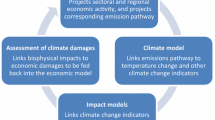Abstract
The impacts of climate change vary significantly across world regions. Whereas tropical and subtropical regions are expected to suffer severely from the effects of climate change, the impacts in northern latitudes should remain relatively moderate. However, regions are not self-sufficient, and the costs of climate change can spread across regions through international trade. I study the international spillover of climate impacts within a regionalised, climate-sensitive, dynamic computable general equilibrium model of the world economy. Using data from a global climate model shows that the world regions face welfare losses between 0.6 and 2.1 % due to climate change. I also show that climate change affects terms of trade and sectoral competitiveness. By means of a decomposition method, the extent of spillover impacts through international trade can be identified. Spillover impacts significantly affect, either positively or negatively, the total costs of climate change for a region. For regions with low exposure to climate change and high adaptive capacities, spillover effects are responsible for a 1/6 of the total cost of climate change.
Similar content being viewed by others
References
Armington P (1968) A theory of demand for products distinguished by place of production. IMF workingpaper
Balassa B (1965) Trade liberalisation and revealed comparative advantage. Manch Sch 33(2): 99–123
Bättig MB, Wild M, Imboden D (2007) A climate change index: where climate change may be most prominent in the 21st century. Geophys Res Lett 34: 1–6
Baxter M, Kouparitsas M (2005) Determinants of business cycle comovement: a robust analysis. J Monet Econ 52(1): 113–157
Blake E, Rappaport E, Landsea C (2007) The deadliest, costliest, and most intense United States tropical cyclones from 1851 to 2006 (and other frequently requested hurricane facts). National Oceanic and Atmospheric Administration (NOAA)—National Hurricane Center (NHC), US Department of Commerce-Technical Memorandum NWS TPC-5
Böhringer C, Rutherford TF (2004) Who should pay how much?. Comput Econ 23(1): 71–103
Brooks N, Adger NW, Kelly MP (2005) The determinants of vulnerability and adaptive capacity at the national level and the implications for adaptation. Glob Environ Change 15(2): 151–163
Cline WR (2007) Global warming and agriculture. Center for Global Development. Peterson Institute for International Economics
DECC (2011) Energy price statistics. UK Department of Energy and Climate Change
EIA (2011) US weekly retail gasolineprices. US Energy Information Administration
Fankhauser S, Tol R (2005) On climate change and economic growth. Resour Energy Econ 27(1): 1–17
Feldstein M, Horioka C (1980) Domestic saving and international capital flows. Econ J 90(358): 29–314
Frankel J, Rose A (1998) The endogenity of the optimum currency area criteria. Econ J 108(449): 1009–1025
Gordon R, Bovenberg A (1996) Why is capital so immobile internationally? Possible explanations and implications for capital income taxation. Am Econ Rev 86: 1057–1075
Harrison W, Horridge J, Pearson K (2000) Decomposing simulation results with respect to exogenous shocks. Comput Econ 15(3): 227–249
IPCC (2007a) Assessing key vulnerabilities and the risk from climate change. In: Parry M, Canziani O, Palutikof J, van der Linden P, Hanson C (eds) Climate change 2007: impacts, adaptation and vulnerability. Contribution of working group II to the fourth assessment report of the intergovernmental panel on climate change. Cambridge University Press, Cambridge, pp 779–810
IPCC (2007b) Climate change 2007: the physical science basis. Contribution of working group I to the fourth assessment report of the intergovernmental panel on climate change. Cambridge University Press, Cambridge
Jones BF, Olken BA (2010) Climate shocks and exports. Am Econ Rev 100(2): 454–459
Juliá R, Duchin F (2007) World trade as the adjustment mechanism of agriculture to climate change. Clim Change 82(3): 393–409
Kose M, Yi K (2006) Can the standard international business cycle model explain the relation between trade and comovement?. J Int Econ 68(2): 267–295
Lau MI, Pahlke A, Rutherford TF (2002) Approximating infinite-horizon models in a complementarity format: a primer in dynamic general equilibrium analysis. J Econ Dyn Control 26: 577–609
Mendelsohn R, Morrison W, Schlesinger M, Andronova N (2000) Country-specific market impacts of climate change. Clim Change 45(3): 553–569
Nakicenovic, N, Swart, R (eds) (2000) IPCC special report on emissions scenarios. Cambridge University Press, Cambridge
Narayanan GB, Walmsley TL (2008) Global trade, assistance, and production: the GTAP 7 data base
Nordhaus WD (2010) Economic aspects of global warming in a post-Copenhagen environment. Proc Natl Acad Sci USA 107(26): 11721–11726
Roeckner E, Bauml G, Bonaventura L (2005) IPCC DDC AR4 ECHAM5/MPI-OM SRESA1B run1. World Data Center for Climate. CERA-DB
Rutherford T (1995) Extension of GAMS for complementarity problems arising in applied economic analysis. J Econ Dyn Control 19(8): 1299–1324
Schellnhuber HJ (2009) Tipping elements in the Earth System. Proc Natl Acad Sci 106(49): 20561–20563
Stern N (2007) The economics of climate change: the Stern review. Cambridge University Press, Cambridge
Tol R (2009) The economic effects of climate change. J Econ Perspect 23(2): 29–51
Tol RS (2002) Estimates of the damage costs of climate change: benchmark estimates. Environ Resour Econ 21(1): 47–73
Tol RS, Downing TE, Kuik OJ, Smith JB (2004) Distributional aspects of climate change impacts. Glob Environ Change 14: 259–272
Author information
Authors and Affiliations
Corresponding author
Rights and permissions
About this article
Cite this article
Schenker, O. Exchanging Goods and Damages: The Role of Trade on the Distribution of Climate Change Costs. Environ Resource Econ 54, 261–282 (2013). https://doi.org/10.1007/s10640-012-9593-z
Accepted:
Published:
Issue Date:
DOI: https://doi.org/10.1007/s10640-012-9593-z




